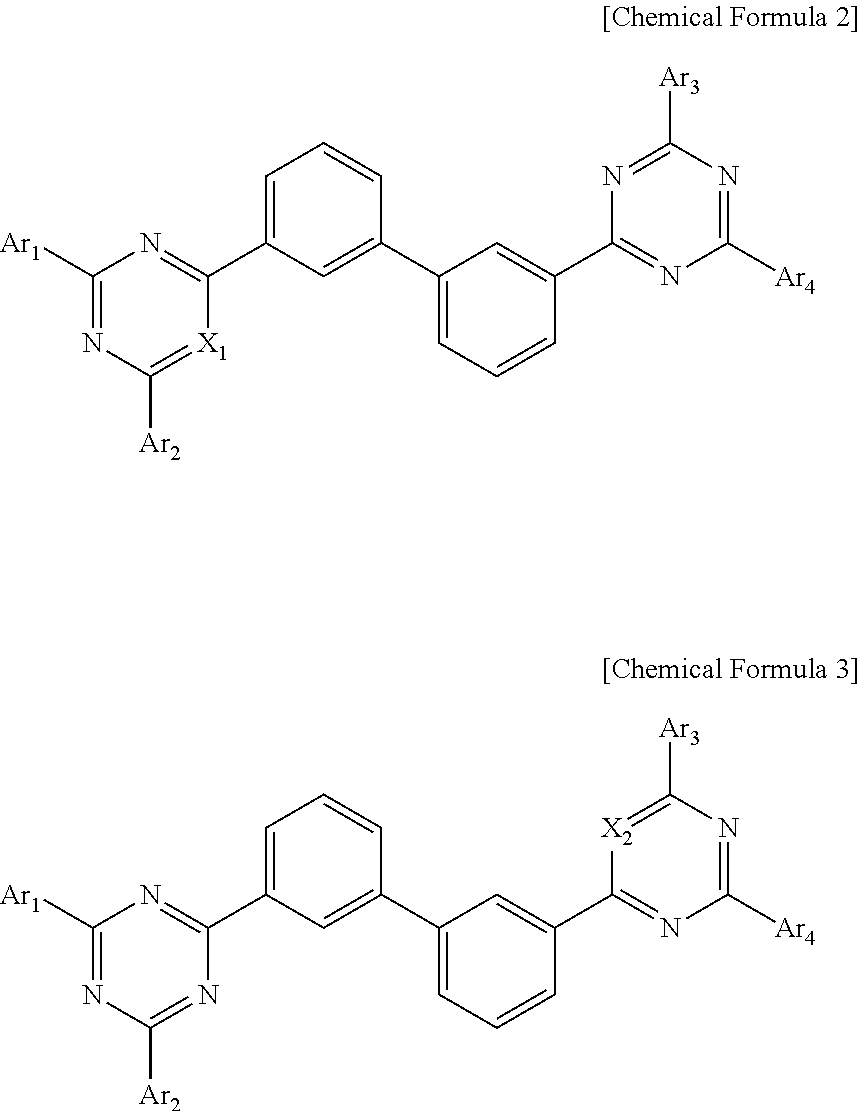Organic compound and organic electroluminescent device using the same
- Summary
- Abstract
- Description
- Claims
- Application Information
AI Technical Summary
Benefits of technology
Problems solved by technology
Method used
Image
Examples
preparation example 2
[Preparation Example 2] Synthesis of Compound Z-2
Synthesis of 2,4-dichloro-6-(triphenylen-2-yl)-1,3,5-triazine
[0079]
[0080]A solution was prepared by dissolving Mg (0.24 g, 10 mmol) and 12 (0.1 g) in dry THF (30 mL), adding 2-bromotriphenylene (3.07 g, 10 mmol) thereto, and then refluxing the mixture for 2 hours. 2,4,6-trichloro-1,3,5-triazine (1.84 g, 10 mmol) was dissolved in dry THF (30 mL) and cooled to 0° C., the previously prepared solution was then slowly added thereto for 1 hour, and the mixture was stirred for 2 hours. After the reaction was completed, the organic layer was dried over MgSO4, concentrated under reduced pressure, and purified with hexane, thereby obtaining a compound 2,4-dichloro-6-(triphenylen-2-yl)-1,3,5-triazine (2.06 g, yield 55%).
[0081]1H-NMR: δ 7.60 (m, 6H), 8.15 (d, 1H), 8.30 (m, 2H), 9.27 (s, 1H), 9.60 (d, 1H)
Synthesis of 2-([1,1′:2′,1″-terphenyl]-3-yl)-4-chloro-6-(triphenylen-2-yl)-1,3,5-triazine
[0082]
[0083]A solution was prepared by dissolving Mg (...
preparation example 3
[Preparation Example 3] Synthesis of Compound Z-3
[0088]
[0089]The same process as in [Preparation Example 1] was carried out, except that 2-(4,4,5,5-tetramethyl-1,3,2-dioxaborolan-2-yl)quinoline (2.55 g, 10.0 mmol) was used instead of (9,9-dimethyl-9H-fluoren-2-yl)boronic acid, and that phenanthren-2-ylboronic acid (2.22 g, 10.0 mmol) was used instead of (9-phenyl-9H-carbazol-3-yl)boronic acid, such that the target compound, Compound Z-3 (3.45 g, yield 59%), was obtained.
[0090]1H-NMR: δ 1.20 (s, 12H), 7.54 (m, 2H), 7.66 (m, 5H), 7.85 (m, 7H), 8.21 (d, 1H), 8.46 (s, 1H), 8.70 (m, 2H), 9.11 (d, 1H), 9.19 (s, 1H)
preparation example 4
[Preparation Example 4] Synthesis of Compound Z-4
[0091]
[0092]The same process as in [Preparation Example 2] was carried out, except that 6-bromo-2-phenylbenzo[d]oxazole (2.74 g, 10.0 mmol) was used instead of 2-bromotriphenylene, and that 2-(4-bromophenyl)-1-phenyl-1H-benzo[d]imidazole (3.49 g, 10.0 mmol) was used instead of 3-bromo-1,1′:2′,1″-terphenyl, such that the target compound, Compound Z-4 (3.78 g, yield 58%), was obtained.
[0093]1H-NMR: δ 7.30 (m, 3H), 7.50 (m, 10H), 7.80 (m, 3H), 7.96 (m, 5H), 8.16 (m, 3H), 8.56 (d, 1H)
PUM
 Login to View More
Login to View More Abstract
Description
Claims
Application Information
 Login to View More
Login to View More - R&D Engineer
- R&D Manager
- IP Professional
- Industry Leading Data Capabilities
- Powerful AI technology
- Patent DNA Extraction
Browse by: Latest US Patents, China's latest patents, Technical Efficacy Thesaurus, Application Domain, Technology Topic, Popular Technical Reports.
© 2024 PatSnap. All rights reserved.Legal|Privacy policy|Modern Slavery Act Transparency Statement|Sitemap|About US| Contact US: help@patsnap.com










